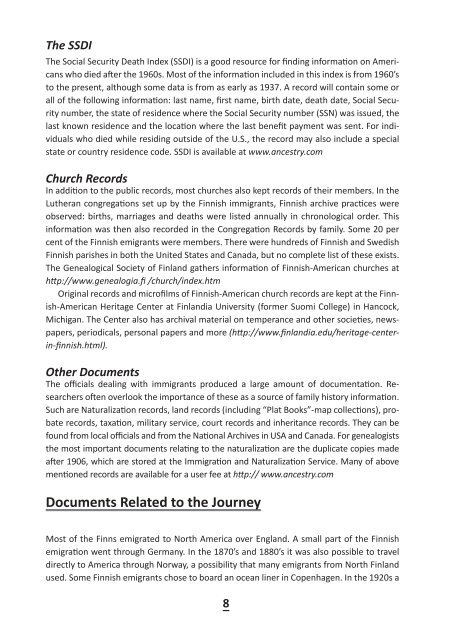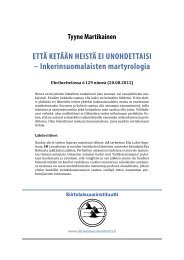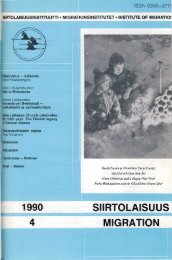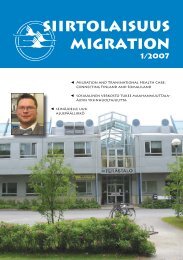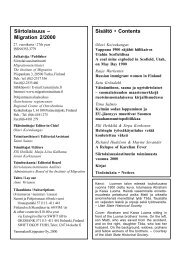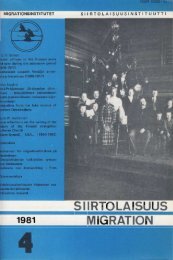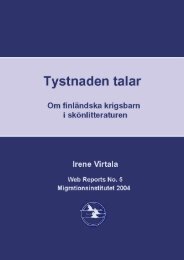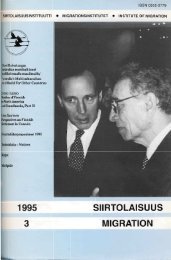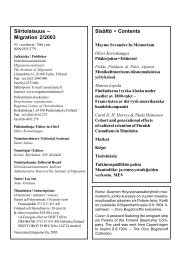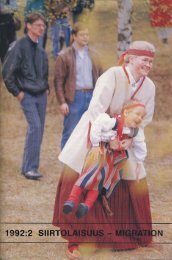How to trace your roots in Finland - Siirtolaisuusinstituutti
How to trace your roots in Finland - Siirtolaisuusinstituutti
How to trace your roots in Finland - Siirtolaisuusinstituutti
Create successful ePaper yourself
Turn your PDF publications into a flip-book with our unique Google optimized e-Paper software.
The SSDI<br />
The Social Security Death Index (SSDI) is a good resource for f<strong>in</strong>d<strong>in</strong>g <strong>in</strong>formation on Americans<br />
who died after the 1960s. Most of the <strong>in</strong>formation <strong>in</strong>cluded <strong>in</strong> this <strong>in</strong>dex is from 1960’s<br />
<strong>to</strong> the present, although some data is from as early as 1937. A record will conta<strong>in</strong> some or<br />
all of the follow<strong>in</strong>g <strong>in</strong>formation: last name, first name, birth date, death date, Social Security<br />
number, the state of residence where the Social Security number (SSN) was issued, the<br />
last known residence and the location where the last benefit payment was sent. For <strong>in</strong>dividuals<br />
who died while resid<strong>in</strong>g outside of the U.S., the record may also <strong>in</strong>clude a special<br />
state or country residence code. SSDI is available at www.ancestry.com<br />
Church Records<br />
In addition <strong>to</strong> the public records, most churches also kept records of their members. In the<br />
Lutheran congregations set up by the F<strong>in</strong>nish immigrants, F<strong>in</strong>nish archive practices were<br />
observed: births, marriages and deaths were listed annually <strong>in</strong> chronological order. This<br />
<strong>in</strong>formation was then also recorded <strong>in</strong> the Congregation Records by family. Some 20 per<br />
cent of the F<strong>in</strong>nish emigrants were members. There were hundreds of F<strong>in</strong>nish and Swedish<br />
F<strong>in</strong>nish parishes <strong>in</strong> both the United States and Canada, but no complete list of these exists.<br />
The Genealogical Society of F<strong>in</strong>land gathers <strong>in</strong>formation of F<strong>in</strong>nish-American churches at<br />
http://www.genealogia.fi /church/<strong>in</strong>dex.htm<br />
Orig<strong>in</strong>al records and microfilms of F<strong>in</strong>nish-American church records are kept at the F<strong>in</strong>nish-American<br />
Heritage Center at F<strong>in</strong>landia University (former Suomi College) <strong>in</strong> Hancock,<br />
Michigan. The Center also has archival material on temperance and other societies, newspapers,<br />
periodicals, personal papers and more (http://www.f<strong>in</strong>landia.edu/heritage-center<strong>in</strong>-f<strong>in</strong>nish.html).<br />
Other Documents<br />
The officials deal<strong>in</strong>g with immigrants produced a large amount of documentation. Researchers<br />
often overlook the importance of these as a source of family his<strong>to</strong>ry <strong>in</strong>formation.<br />
Such are Naturalization records, land records (<strong>in</strong>clud<strong>in</strong>g “Plat Books”-map collections), probate<br />
records, taxation, military service, court records and <strong>in</strong>heritance records. They can be<br />
found from local officials and from the National Archives <strong>in</strong> USA and Canada. For genealogists<br />
the most important documents relat<strong>in</strong>g <strong>to</strong> the naturalization are the duplicate copies made<br />
after 1906, which are s<strong>to</strong>red at the Immigration and Naturalization Service. Many of above<br />
mentioned records are available for a user fee at http:// www.ancestry.com<br />
Documents Related <strong>to</strong> the Journey<br />
Most of the F<strong>in</strong>ns emigrated <strong>to</strong> North America over England. A small part of the F<strong>in</strong>nish<br />
emigration went through Germany. In the 1870’s and 1880’s it was also possible <strong>to</strong> travel<br />
directly <strong>to</strong> America through Norway, a possibility that many emigrants from North F<strong>in</strong>land<br />
used. Some F<strong>in</strong>nish emigrants chose <strong>to</strong> board an ocean l<strong>in</strong>er <strong>in</strong> Copenhagen. In the 1920s a<br />
8


